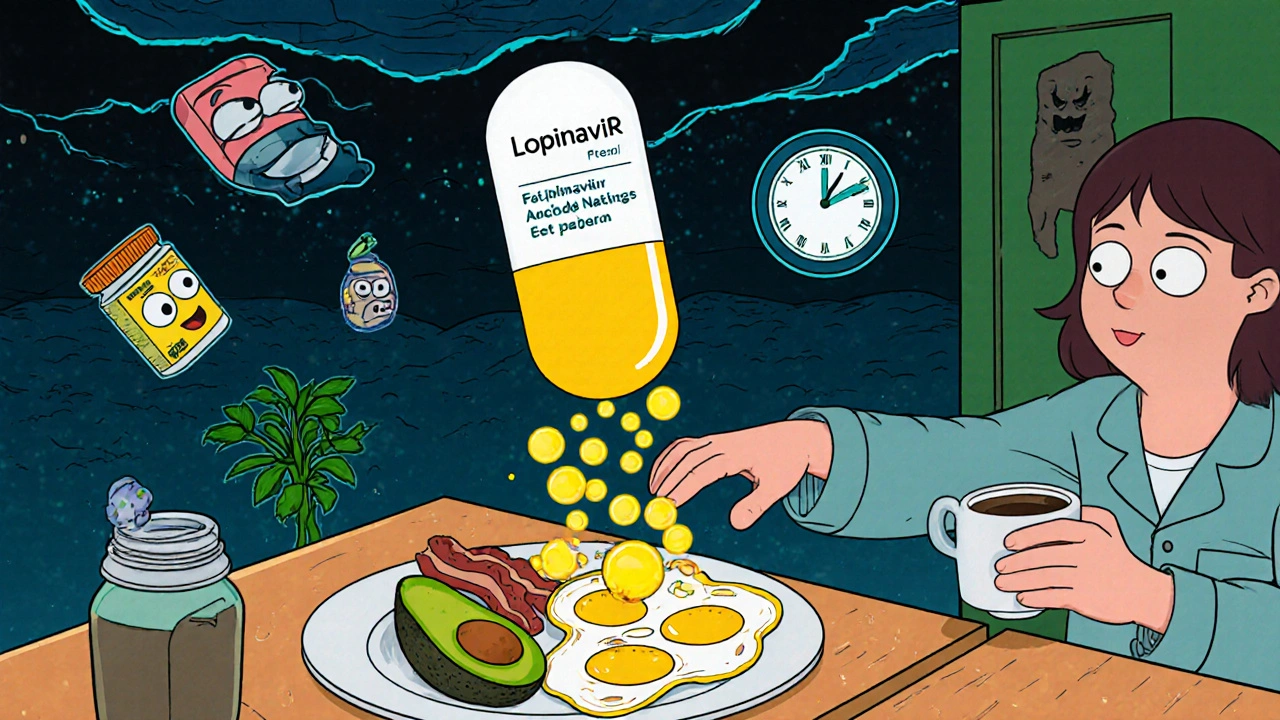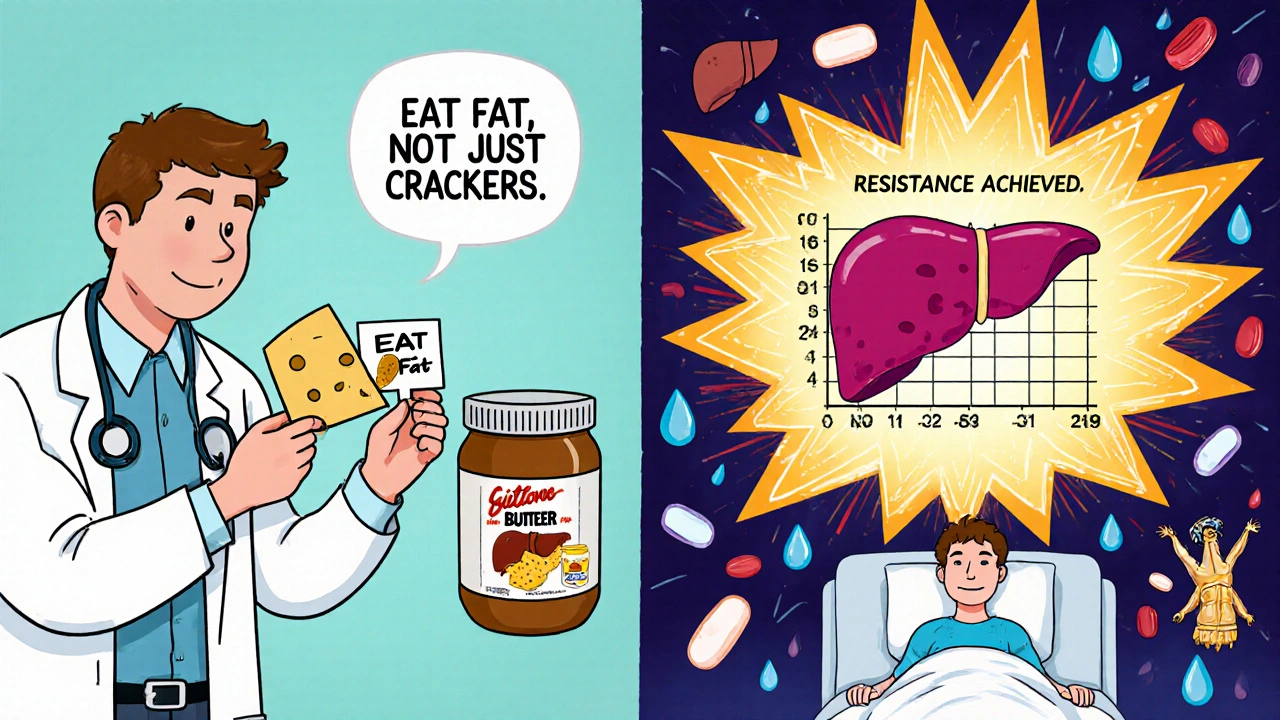 Oct, 27 2025
Oct, 27 2025
When you take lopinavir for HIV, it’s not just about swallowing a pill. What you eat, when you take it, and even what other drugs you’re on can change how well it works. Lopinavir is a powerful antiretroviral, but it’s finicky. If you take it on an empty stomach, you might not get enough of it into your bloodstream. If you take it with the wrong kind of meal, it could cause side effects or even lead to treatment failure. This isn’t theoretical-real people on lopinavir have seen their viral loads spike because they didn’t know how food affects absorption.
How Lopinavir Gets Into Your Blood
Lopinavir is a protease inhibitor. It works by blocking HIV from copying itself inside your cells. But for it to do that, it needs to get into your bloodstream first. That’s where drug absorption comes in. Unlike some medications that absorb easily no matter what, lopinavir has low and unpredictable oral bioavailability. That means only a small portion of the pill you swallow actually makes it into your system. The rest gets broken down by your liver or just passes through.
Here’s the catch: lopinavir is usually given with ritonavir, which slows down how fast your body breaks it down. Together, they’re sold as Kaletra. But even with ritonavir boosting it, lopinavir still needs help from food to absorb properly. Studies show that taking lopinavir with food can increase its absorption by up to 50%. That’s not a small boost-it’s the difference between suppressing the virus and letting it bounce back.
The Role of Food in Lopinavir Absorption
Not all food is created equal when it comes to lopinavir. High-fat meals work best. Research from the Journal of Acquired Immune Deficiency Syndromes found that taking lopinavir with a meal containing at least 500 calories and 20 grams of fat led to the highest blood levels. A light snack? Not enough. A low-fat yogurt? Probably too little. A full meal with eggs, avocado, or peanut butter? That’s what your body needs.
Why does fat matter? Lopinavir is lipophilic-it dissolves better in fat than in water. When you eat fatty food, your body releases bile and other digestive fluids that help dissolve the drug so your intestines can absorb it. Without that fat, lopinavir just sits there, mostly unchanged, and gets flushed out.
But timing matters too. If you take lopinavir right after a big meal, you might feel nauseous. If you take it too long after eating, absorption drops. The sweet spot is taking it within 30 minutes after finishing a meal. That gives your digestive system time to start working but not so long that the fat has already moved on.
What Happens If You Skip Food?
Some people skip meals to avoid side effects like diarrhea or stomach upset. Others are in a rush and grab the pill on the way out the door. But skipping food with lopinavir isn’t just inconvenient-it’s risky.
One study tracked 120 people on lopinavir/ritonavir. Half took it with food, half didn’t. After six months, the group taking it on an empty stomach had 37% lower drug levels in their blood. More than 20% of them developed detectable viral loads. That’s not just a blip-it’s a sign the treatment was failing. Some of them had to switch medications because resistance started to build.
Low drug levels don’t just mean the virus comes back. They also increase the chance of HIV mutating into a strain that resists lopinavir and other similar drugs. Once that happens, your options shrink. You might need more expensive, harder-to-tolerate pills. Or worse-you might lose access to entire classes of HIV meds.
Other Factors That Change Lopinavir Absorption
Food isn’t the only thing that messes with lopinavir. Other drugs can interfere too. Antacids, for example, raise the pH in your stomach. Lopinavir needs a low pH to dissolve properly. If you take an antacid like Tums or omeprazole within two hours of lopinavir, absorption drops sharply. Same goes for some herbal supplements. St. John’s wort, often used for depression, speeds up liver enzymes that break down lopinavir-making it less effective.
Alcohol doesn’t directly block absorption, but heavy drinking can damage your liver. Since lopinavir is processed by the liver, any damage there can change how quickly it’s cleared from your body. People with fatty liver disease or hepatitis C often need dose adjustments.
Even your gut health matters. If you have chronic diarrhea, Crohn’s disease, or have had gastric bypass surgery, your ability to absorb lopinavir can drop significantly. In these cases, doctors may need to monitor blood levels more closely or switch to a different drug like darunavir, which is less affected by gut changes.
Real-Life Scenarios That Break the Rules
Imagine someone who works night shifts. They take their meds at 3 a.m. and have a snack of crackers and tea. That’s not enough fat. Their lopinavir levels stay low. Over time, the virus adapts.
Or someone who travels often. They’re in a different time zone. Their usual meal isn’t available. They skip food to avoid jet lag nausea. The next day, their viral load jumps.
Or a person on a tight budget. High-fat meals cost more. They rely on rice and beans. Lopinavir doesn’t absorb well. They feel fine-until their next test shows the virus is active again.
These aren’t rare cases. Clinics in Brisbane, Johannesburg, and Mexico City report the same pattern: people who follow their pill schedule perfectly still fail treatment because they don’t know how food changes the game.

What to Do Instead
Here’s what works:
- Take lopinavir within 30 minutes after eating a meal with at least 500 calories and 20 grams of fat.
- Avoid antacids, proton pump inhibitors, and H2 blockers within two hours of your dose.
- Don’t take St. John’s wort, certain antibiotics like rifampin, or seizure meds like carbamazepine without checking with your doctor.
- If you’re traveling, pack a high-fat snack-nuts, cheese, peanut butter packets. Don’t rely on hotel breakfasts.
- Keep a simple log: date, time, meal content, and any side effects. Bring it to every appointment.
Some clinics now give patients a small card with this info. It’s not fancy, but it works. One study found that patients who carried the card were 60% more likely to take lopinavir with food consistently.
What If You Can’t Eat a Full Meal?
If you’re sick, nauseous, or just can’t eat much, talk to your doctor. There are alternatives. Darunavir, for example, is boosted with ritonavir too, but it doesn’t need high-fat meals to work. Atazanavir is another option that’s less affected by food. Your doctor might switch you if food restrictions are too hard to manage.
There’s also a new formulation of lopinavir being tested-capsules that release the drug in the intestine instead of the stomach. Early results show it’s less dependent on food. But it’s not widely available yet.
Bottom Line: Lopinavir Needs Food to Work
Lopinavir isn’t like a vitamin you can take anytime. It’s a precision tool. Take it without food, and you’re not just reducing its effect-you’re risking drug resistance, treatment failure, and long-term health consequences. The science is clear. The data is real. And the solution is simple: eat with your pill.
It’s not about being perfect. It’s about being consistent. Even if you can’t always have a full meal, aim for something fatty, something filling, something that gives your body a fighting chance to absorb the drug. Your future self will thank you.
Can I take lopinavir with just a banana or toast?
No. A banana or toast alone won’t help. Lopinavir needs at least 20 grams of fat and around 500 calories to absorb properly. A banana has almost no fat. Toast with jam is mostly carbs. You need something like peanut butter on whole grain, scrambled eggs with cheese, or a small portion of avocado toast with olive oil.
What if I forget to eat and already took lopinavir?
Don’t take another dose. Taking more can cause dangerous side effects like liver toxicity. Instead, eat a fatty snack as soon as you can, even if it’s an hour later. Your body will still absorb some of the drug. But make sure to take your next dose on time with food. If this happens often, talk to your doctor about switching medications.
Does alcohol affect lopinavir absorption?
Alcohol doesn’t directly block absorption, but heavy or regular drinking can damage your liver, which processes lopinavir. If your liver isn’t working well, the drug may build up too high or clear too fast. Either way, it’s risky. Limit alcohol to occasional small amounts, and always tell your doctor how much you drink.
Can I take lopinavir with coffee?
Coffee alone isn’t enough. You still need a proper meal with fat. But if you’re having coffee with a high-fat breakfast-like eggs and buttered toast-that’s fine. Avoid taking lopinavir with just coffee and a sugary pastry. That won’t help absorption and might upset your stomach.
Is there a liquid form of lopinavir that doesn’t need food?
The liquid form of lopinavir (Kaletra oral solution) still requires food for proper absorption. In fact, it’s even more sensitive to stomach pH and food intake than the tablets. It’s mainly used for children or people who can’t swallow pills, but the same food rules apply. Always take it with food.

Keith Bloom
October 29, 2025 AT 06:26Meredith Poley
October 30, 2025 AT 20:00Ben Jackson
October 31, 2025 AT 20:51Bhanu pratap
November 1, 2025 AT 01:15Ikenga Uzoamaka
November 2, 2025 AT 23:04Lee Lee
November 4, 2025 AT 15:58John Greenfield
November 4, 2025 AT 21:12Melissa Thompson
November 6, 2025 AT 03:25Mathias Matengu Mabuta
November 6, 2025 AT 19:21Ashley Tucker
November 8, 2025 AT 09:08Allen Jones
November 9, 2025 AT 07:31jackie cote
November 10, 2025 AT 02:37Dr. Alistair D.B. Cook
November 10, 2025 AT 13:03